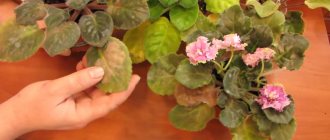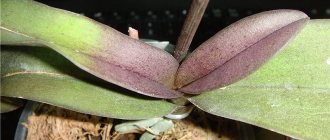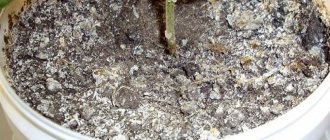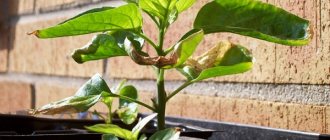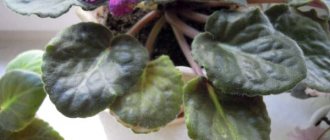Violets (Saintpaulias), like many indoor plants, are susceptible to various diseases and pests. It is fair to note that if all necessary preventive measures and appropriate care are observed, the risk of injury is minimized. And yet you should know what the most common diseases and pests of violets exist and what methods and means to combat them.
Violet disease - rot of leaves and roots and their treatment
Symptoms of this violet disease include:
- loss of leaf turgor;
- loss of the natural color of the rosette;
- wilting of petioles and leaf blades.
Latest articles about gardening
How to feed thuja in the summer? How to feed violets to bloom at home. How to feed violets?
Given the comprehensive nature of the violet disease, as in the photograph, treatment can only be urgent and drastic. Damaged tissue is removed, Saintpaulia is rooted using a healthy leaf that can produce new rosettes.
Very young rosettes, children and rooted leaves are susceptible to brown rot In the latter case, the stem at the base becomes brownish-brown, softens and thins. On the soil under the rosette, whitish threads of mycelium are found. And if urgent measures are not taken, the violet disease spreads to neighboring plants.
As a preventive measure, rooted plants are treated with a contact fungicide, not buried, and then the area under the stem is irrigated with phytosporin or a chemical similar in action.
Gray rot also leads to liquefaction and weakening of the green parts of the plant, while a gray fluffy coating is clearly visible on the affected surface. All leaves with signs of violet disease, as well as dead leaf blades and cuttings, are removed, preventing them from falling to the ground. To reduce the risk of infection during the cool season, it is extremely important:
- avoid excessive air humidity;
- stop spraying sockets;
- Water the violets correctly, avoiding stagnation of moisture and the formation of condensation.
Among the chemicals used to treat sockets and protect them, they choose fast and funda ash.
Brown spots on violet leaves
Household violets rarely suffer from fungus, but this happens much more often with outdoor flower beds. And the first symptoms may be rusty, brown or brown spots on the leaves.
— Large brown spots appear on delicate leaves from cold and drafts;
— The leaves turn brown when the violet lacks nutrients. Indeed, during flowering, it absorbs them twice as actively;
— Textured red spots appear when damaged by rust. She likes humid but fairly cool days. Sometimes orange bumps appear;
— Brown soft shoots and leaves are a sure sign of brown rot of the same name, which most often affects young plants;
— Brown spots on the leaves due to late blight dry out and spread almost before our eyes;
— The leaves begin to darken and rot from the stem and petiole if the violet suffers from fusarium. The disease affects the root system, and it is almost impossible to cure it;
— Chaotic brown streaks combined with a stop in development indicate an incurable bronze virus;
— The leaves darken at the edges when the violet soil is too wet and needs to be dried.
Photo: aa2aa.ru
Petunia leaf diseases: descriptions with photos, treatment
Powdery mildew on Saintpaulias and treatment
This is a disease of violet leaves, the causative agents are powdery mildew fungi - parasites. These fungi reproduce by spores and grow quickly in favorable conditions, therefore, with this disease, small white dots first appear on the leaves, which increase in size and can envelop, as if in a white cobweb, the entire surface of the leaf. A white coating may appear on the outside and inside of the leaves; flower buds may also be affected.
A favorable environment for the development of fungi is low temperature and high humidity. Young and newly transplanted plants are most susceptible to powdery mildew infection. Powdery mildew infection can occur: when watering, from an infected plant to a healthy one, fungal spores can be carried by insects or air currents.
Treatment of a flower for powdery mildew can be done either using ordinary sulfur or using antifungal drugs for violets. There are also many traditional medicines to combat powdery mildew - this is the treatment of plants with various solutions. You can prepare these solutions yourself: from soda ash with soap, whey, kefir, dry mustard, potassium permanganate, ash, mullein, infusion of horsetail, garlic, onion peels. To avoid the development of powdery mildew, it is necessary not to create favorable conditions for fungi.
Causes of leaf rotting
The appearance of rot is one of the dangerous symptoms that should be responded to immediately. To take appropriate action, the first step is to determine the root cause of the problem. Most often, rotting of violet leaves occurs as a result of:
- natural process of death,
- root rotting,
- non-compliance with watering rules,
- excessive enthusiasm for feeding,
- wrong choice of flower pot,
- damage by fungal diseases such as gray rot, powdery mildew, late blight and fusarium.
Fucarium disease of violets and treatment
Signs: browning of petioles and falling leaves of violets.
Causes: This is a disease caused by a fungus of the genus Fusarium. From the soil, the fungus enters the roots of the plant and infects the vessels of all its parts - the stem, peduncles, leaf cuttings. These fungi release toxic substances that cause browning and rotting. It appears, like late blight, with excessive watering and cold. Its appearance is facilitated by sudden temperature changes, watering with cold water, and the heavy granulometric composition of the soil, which causes water to stagnate in it.
Treatment: the same treatment is used as for late blight. In addition to phytosporin, for preventive purposes, you can water the foundation with azole. To do this, dilute 1 gram of funda ash in 1 liter of water. Watering is carried out once every two months.
Leaves turn yellow and dry out
It is a pity if large violet leaves begin to dry out, especially when they should not do so. But this is exactly the problem that flower growers face most often!
— Violet leaves turn yellow and wither if the conditions are not suitable for it, because each variety has its own characteristics;
— Leaves may turn yellow if they are constantly exposed to water when watering;
— Ring yellow spots appear in winter when the flowerpot is in a draft;
— The plant turns yellow, becomes stunted and lethargic due to root rot. Then urgent drying and replanting with fungicide treatment is needed;
— Wide yellow trails on the leaves are left by thrips when they eat away the pulp.
Photo: raiclimat.ru
Violet leaf spot and treatment
Viral diseases can slow down the development of violets, change the appearance of the plates and stop flowering.
The causes of the spread of the disease may be the colonization of the flower by parasites. The bronzing virus is accompanied by the appearance of disfigured leaves, colored brownish.
Viral diseases cannot be treated, so the plant is destroyed.
Latest articles about gardening
Catharanthus: cultivation and care, photo Drip irrigation from bottles in a greenhouse Cabbage: planting seedlings timing
Late blight of Saintpaulia rosettes and treatment
A sign of late blight is brown, dry spots on the leaf part of the plant. The spots spread very quickly. In the shortest possible time, the plant tissue undergoes necrosis and the rosette withers.
If the top of the rosette is not damaged, then you can cut it off, treat it with a fungicide, cut off the damaged areas and root it. Individual leaves are also suitable for rooting.
The remaining part of the flower is destroyed. Neighboring flowers must be treated.
Bronze and violet leaf spot viruses and treatment
Viral diseases change the appearance of leaf blades, tissue supply and plant development. These diseases can be the reason why violets do not bloom at home, and then stop developing altogether.
The bronzing virus, for example, causes malformed leaves with discoloration. Such plants sometimes turn out to be unviable and are destroyed. And pests that are also found in apartments can spread the disease of violets. In this case it's thrips.
Gray rot on violets and its treatment
Other indoor plants suffer from this fungal disease, not just Saintpaulia. The infection affects the tissue of young seedlings, leaves, flowers and buds. The plant turns brown, rots, or becomes covered with a gray-brown coating. The violet becomes covered with brown spots, which quickly spread throughout the plant. Typically, this type of parasite penetrates weakened plants through mechanical damage. In this case, you need to spray with a copper-soap solution (dilute 20 g of liquid potassium soap and 2 g of copper sulfate in 1 liter of water). In order to avoid infection, experts recommend carrying out preventive procedures. Feed with fertilizers and microelements, which significantly increase the plant’s resistance.
Caring for violets at home
Violet lighting
If you have a lot of windows, choose an area in your home that has the most indirect soft light. Violets should be placed on a southern windowsill with caution, as they do not like direct sunlight, so on a southern windowsill you need to shade them: cover the window to the height of the flowers' growth with curtains. If you spend a lot of time in the kitchen, you can also place flowerpots with Saintpaulias there. Firstly, their presence will make you feel comfortable, and secondly, violets like high humidity and good light in the kitchen.
If your house violets don't get enough light, they may look pale and lethargic. The leaves will stretch upward, the stalk will lengthen, which means the harmonious shape of the rosette will be disrupted.
Watering violets
I water my violet plants 1-2 times a week (depending on the season). I use soft, settled water at room temperature. Some novice Saintpaulia lovers water them, like other flowers, directly from above into the ground. But this must be done extremely carefully. Moisture should not get on the violet leaves, much less on the flower growth points. Stagnation of water on cuttings or leaves leads to their rotting. I prefer to water violets not in the ground, but by pouring water into a tray up to 2/3 of the height of the pot. Flower growers call this “bottom watering.” But under no circumstances should you leave water in the pan “in reserve.” Roots should breathe, not float! Therefore, 20-30 minutes after the soil is saturated with moisture, I drain the remaining water.
Violets cannot be sprayed, but they, like other flowers, love moist air. Therefore, place a container of clean water next to the flowerpots or place pieces of damp cloth or a wet sponge.
Latest articles about gardening
When to harvest spinach? Lantana: care at home Moles: how to deal with them?
Transplanting violets
Planting a flower will not be difficult even for a novice gardener. First you need to remove the plant from the pot. Then clean the roots from the old soil composition and look at them carefully. If sluggish, damaged or dry root shoots and leaves are found, it is recommended to remove them immediately. But do not rush to plant the plant after this.
The cut areas will need to be treated with activated carbon, ground into powder. Remember: if a significant part of the root system has been cut off, it is advisable to transplant the flower into a smaller flowerpot. Now all you have to do is fill the pot with a layer of drainage, soil mixture, and then place the houseplant there.
As for the classic method of planting violets with a leaf blade, everything is quite simple. But there is another common method - transshipment. It is often used when a flower needs to be saved from disease. That is, you will not need to completely clear the Saintpaulia root system from the soil.
When planting, you only partially update the soil composition. If the old blooming violet is planted according to all the rules, you will soon see how much better it begins to bloom. Take care of your pet and you will be satisfied with the result. Let the violet bloom throughout the year, and caring for it will not become a burdensome task for you.
A few reasons
Saintpaulia leaves can rot for multiple reasons. For example, this plant of African origin (violet) is adversely affected by low humidity, bright sun and cold (low temperatures). But bending in the other direction is fraught with dangerous problems for the flower - violets sometimes rot due to too high temperatures.
The main reasons for the rotting of Saintpaulia leaves:
- Die-off (physiological natural process);
- Rotting (from roots), due to excessive watering or unsuitable substrate;
- Water falling on the leaves during watering;
- Overfeeding – excess fertilizer;
- A pot that is too large can cause fungus to grow in it;
- Gray rot or fusarium is a fungal disease of violets.
As for the natural age-related death of foliage, this is an absolutely normal process. The lower rows begin to dry out, turn yellow and die, receiving moisture from the soil. To prevent rotting, such leaves must be removed in time. However, a dangerous sign is the appearance of yellowness or rotting not only on the lower leaves, but on the entire plant. Then you should seriously think about the possible pathology of Saintpaulia.
Lethargy of the bottom row under conditions of good watering may indicate problems with the root system of the violet. Rotting spreads quite quickly, and soon spreads from the roots to the leaves. This unpleasant process can be caused by unsuitable soil - factors such as increased soil density, or too low soil temperature, or, conversely, its excess heat provoke the onset of rotting of the root system.
To prevent such troubles, you should be good at proper watering and choosing the right substrate. The soil must be highly permeable to water and especially air, that is, light. If it is not possible to buy a normal soil mixture specifically suitable for Saintpaulias, it is necessary to add vermiculite (perlite) or sand to the soil.
As for watering, waterlogging is very dangerous for this type of plant. Violets are watered only when the earthen clod dries out. Sub-bottom watering or wick watering is best suited for Saintpaulia - they ensure normal water permeability of the soil and ideal humidity in the pot. With pallet irrigation, the tray itself is filled with expanded clay or even pebbles.
Getting water on the leaves is the main mistake of many gardeners. Under no circumstances should you water a flower from above, onto the rosette - only along the walls, into the soil itself. And spraying should be extremely careful - best on the underside of the leaves.
If the humidity in the room is not too high, then, especially during the heating season, it is necessary to use a humidifier. If you don't have one, you can at least hang wet towels on hot radiators. This is useful for both indoor plants and the respiratory tract of apartment owners.
The next common mistake in caring for the growth of Saintpaulias is overfeeding. Much does not mean good. This delicate flower should not be fertilized more often than once every 15 days, and in the winter months - once every four weeks. In this case, fertilizers must be specially designed for violets, and if they are universal for indoor flowers, then the concentration must be doubled. Moreover, the concentration must also depend on the age of the violet. Otherwise, the leaves will begin to fall off, turn yellow, or even rot.
Fungal diseases are a very dangerous pathology for Saintpaulias. They develop so quickly that you often have to simply throw the flower away, getting rid of both the pot and the soil. But in the initial stages of the disease, the violet can still be saved. However, the main treatment is proper prevention.
If the temperature regime, normal humidity in the room, and the correct regime of fertilizers for violets are observed, they will not face a disease such as gray rot. An excellent preventative procedure would also be special watering with specific microelements so that a plant such as violet becomes more resilient and less susceptible to fungal infections.
If the disease does spread, then you need to know what gray rot looks like: dark-colored spots appear on flowers, stems, and foliage - the leaves change their appearance and wither. A gray coating of mycelium quickly begins to appear on these spots. After this, rotting of these parts of the violet infected with this fungus begins. Then it is urgent to remove these parts and treat the violet with a fungicide in the fresh air.
When the roots of Saintpaulia rot, the disease is called fusarium (in some cases). Lethargy and death of the lower layer of foliage are the first symptoms of this pathology. Developing rapidly, the disease completely kills the entire violet. But at the initial stages (when the leaves are still just a little withered), it can still be saved by using special solutions for treatment against fungi and fusarium in particular.
